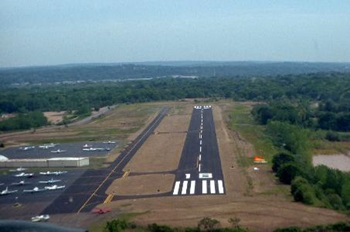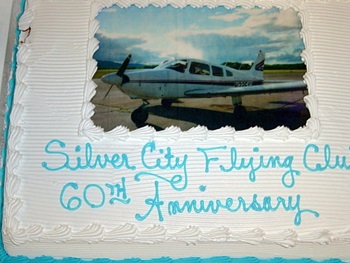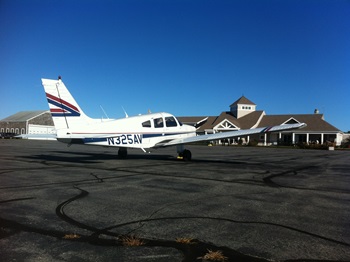 The Silver City Flying Club in central Connecticut was formed in 1946 by bomber pilots returning from World War II. Over the years it was based at Meriden Airport (KMMK) and then just six miles away at Robertson Airport (4B8) in Plainville. Today, it operates two aircraft that it rotates between the two airports. Club President Paul Merola, Sr. talks about the benefits of operating from two airports.
The Silver City Flying Club in central Connecticut was formed in 1946 by bomber pilots returning from World War II. Over the years it was based at Meriden Airport (KMMK) and then just six miles away at Robertson Airport (4B8) in Plainville. Today, it operates two aircraft that it rotates between the two airports. Club President Paul Merola, Sr. talks about the benefits of operating from two airports.
Name: Silver City Flying Club
Location: Robertson Airport (4B8), Plainville, CT and Meriden-Markham Airport (KMMK), Meriden, CT
Website: http://silvercityflyingclub.com
Year formed: 1946
Aircraft: 1981 Cessna 172P ($85/hr); 1979 Piper Archer PA28-181 ($100/hr)
Rates: Tach hours, wet.
Joining fee: $3,000 per share
Monthly dues: $60 per month
Membership: 40 members
Scheduler: Schedulemaster
 Tell me about the club’s history.
Tell me about the club’s history.
There were a few returning aviators from the Second World War that wanted to continue flying. They pulled together and bought a Cessna 120 in November 1946, which is when the club was formed. They also got together socially around the plane. There is a local restaurant close to the airport where they would meet on a Friday night, so it got to be a social thing along with the airplane.
One of the founding members was in the club until a couple of years ago. He recently decided to donate his share to the club. He hasn’t flown in an awfully long time. I organized a 60th anniversary [in 2006]. He and my instructor went for a flight in the Archer. Both were WWII bomber pilots. The instructor flew up into his 90s. I think he flew a B-26 Marauder and the founding member also flew a twin-engine bomber.
What type of aircraft do you have?
We have a 1981 Cessna 172 that has been in the club probably three or four years before I joined in 1991. It has treated us very well and we keep it well maintained. We also have a 1979 Archer that we’ve had since 1997. We upgraded it in 2011, put a GPS panel in there, had the autopilot redone and coupled it, and the interior was redone previous to that. We’re looking at painting that plane in January. We’re doing all this without an assessment. The planes both fly fairly regularly. We used to put probably 300 plus hours on each plane, but now we’re probably half that.
 You have a high wing and a low wing. Do you find members gravitate to one aircraft or the other?
You have a high wing and a low wing. Do you find members gravitate to one aircraft or the other?
Most members fly both of them, but they gravitate to one or the other. Everyone is checked out in both planes. The Archer is a little faster than the Cessna. We’ve got the GPS and the coupled autopilot and that is used by the guys who like the glass panel display and it’s a little more forgiving of an aircraft.
I prefer the Cessna because I have a lot of time in a Cessna. We have some new members that come in and they trained in a Cessna so they’ll fly that for a while. And they’ll say yeah, maybe I’ll go to the Archer. And we have people who say, ‘I’m strictly a Piper man, that’s all I’m going to fly.’ I fly both, but I fly the Cessna more. Physically it’s more comfortable for me to fly.
Tell me about your structure with the airplanes at two airports.
We have one airplane at each airport and we rotate each airplane quarterly between the two airports. The airports are only six miles apart.
We were based at Meriden and there was an FBO that came in and had a lot of rules—no freelance flight instruction, everything had to go through them, no working on your own plane. A lot of planes left the field. The flying club got caught up in that so we opted to leave in 1992. We put both planes down in Plainville.
In 2000 or 2001, I put a motion through and put the plane back here. I had to go to the city of Meriden and we have a permit to operate as co-users of the airport. Flying clubs could masquerade as an FBO easily, selling things, giving flight instruction, but we’re not like that. We just want to fly our plane and not bother anything.
When we put a plane back at Meriden, some members said we like to fly out of Plainville. Since we have a high wing and a low wing we decided to rotate the planes quarterly. That’s what we’ve been doing and it’s worked out OK.
Do you find one airplane flies more at one airport versus the other?
If a member lives close to an airport, he’ll fly at that airport. If somebody wants to do an instrument approach, Meriden has an instrument approach, where Plainville doesn’t.
We don’t have a 50-50 split between the two airports with the members. At one time we had more of a 70-30 mix with Meriden. We moved and the mix shifted over to Plainville.
Have you had any challenges splitting the airplanes between the two airports?
Rotating the planes is the biggest one. The challenge is when someone has a trip scheduled and doesn’t pay attention to where the plane is. To drive to the other airport is about 20 minutes. It’s not exactly a straight line. Flying it’s only a tenth or two at the very most.
What are the advantages of being based at two airports?
When we moved, some members didn’t want to drive to Plainville. So they put their share up for sale and new members bought in that were close to that airport, so our market area is much bigger.
When we had FBOs up and running at both airports and there was a mechanic here at Meriden, we had another opportunity to get another price for work. We didn’t automatically give Plainville the annuals like they did when we were based there with both planes. We had the opportunity to get a second price. So we were able to do a little bit of bargaining, which helped.
Is there a difference in fuel price between the two airports?
The difference between the two airports for fueling is large. At Meriden, they have a self-service gas pump and the prices are probably the lowest in the area. You can check Airnav. [Editor's note: A check on AirNav showed Meriden at $5.85 and Plainville at $6.84 at the time of writing.]
At Plainville you tie the plane up and ask them to top it off and they send a fuel truck out to do it. We try to top off at Meriden if we can. If someone is flying back and they’re going to fly over Meriden, they drop down, top off and fly on to the next airport.
Your rates are very reasonable.
We’re probably the best deal going here in Connecticut as far as rates. If you buy in that equity share for $3,000, the rates are pretty low. If you decide to get out you put your share up for sale. Other flying clubs you pay an initiation fee and that’s gone once you’re in, and if you want to leave, you just leave.
Over here you can get you money back. If you look at the differential between renting and being in the club and the amount of time I’ve flown in the club, I can give my share away because of the differential. It’s a real cost savings.
Our dues are $60 a month and with that our insurance is covered so we don’t need renter’s insurance.
Our rates are tach time, not Hobbs. You get 1.1 or 1.2 hours depending on how you fly it. I know from being an owner, if you’re renting and paying Hobbs time you keep it firewalled until you get to your destination. You want to get there quick. Now as an owner, you may power it back a little bit. You may run it at 65 percent power. You take it a little easier, you’re not in a rush to get there. And that works very well. All of our engines make it to TBO. You save on fuel, and you don’t beat up the engine.
The buy-in is low, the dues are low, the hourly rates are low. How are you able to keep your costs down?
We’ve done our calculations, we’ve figured out our spreadsheet. $85 an hour [for the 172] is running at the bare minimum. Everything is covered except something like a paint job. We have money allocated for an engine, a propeller, annuals; we’ve got it nailed down and tweaked quite a bit.
For the most part, we do things ourselves. We do a lot of our oil changes ourselves but we don’t have a mechanic. We bring it to an FBO. We look at the maintenance. We keep it flying. We look at our rates. We’re really bare bones. But we managed to save some money.
The upgrade on the Archer was about $23,000, which we paid for out of pocket. We had cash for that. That was 2011 and depleted our cash. Here we are three years later and we’ve managed to accumulate some more cash. We’re painting the Archer in January and we budgeted $20,000 for it and we have the money for it.
At times we’ve had members say I’m not flying anymore, I’ve moved out of state and I’ll just give you my share. So we wind up having a share. At one point we had four shares and we sold them. So we have a little extra money that way.